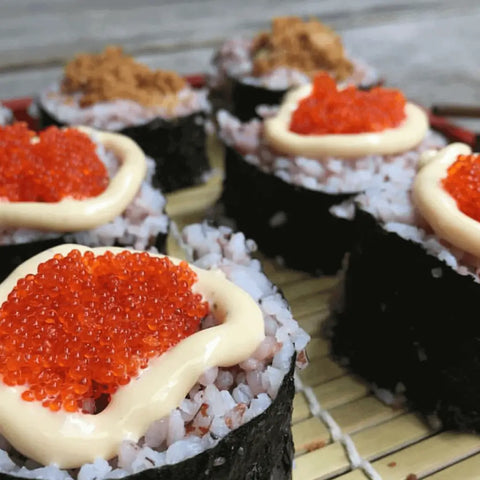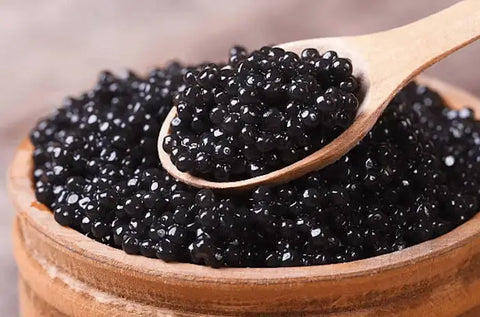If you’re new to the world of caviar, you should know that caviar refers to the fish eggs of the sturgeon family of fish specifically. In this large family of fish, there are about 30 different species, which vary in size, colour, and origin.
Each different species produces different types of caviar that vary in egg size, colour, texture, and of course, flavour.
However, most people refer to all fish eggs as caviar, so we can bucket them into two main categories: sturgeon and non-sturgeon caviar. In this guide, we’ll walk you through the most popular types of caviar for each of the two categories.
Sturgeon Caviar Types
Sturgeon caviar is a precious, delicious, and expensive luxurious delicacy that has been enjoyed for hundreds of years. Nowadays, a few teaspoons of these pearly beads can cost well over $200!
Below, we show our top three picks, break down the most popular and tasty types of sturgeon caviar and dive into their flavour profiles, prices, origins, and more.
Beluga Caviar (Huso Huso) – The Sophisticated
Sitting at the very top of the charts, Beluga caviar originates from the Black and Caspian Seas in Eastern Europe and Western Asia.
Known for their amazing flavour, these large eggs range from light grey to black in colour. Due to its popularity, high demand, and incredible flavour, it’s the most expensive type of caviar in the world.
Beluga caviar is best enjoyed alone or with buttered toast. It’s the ideal type to make a lasting impression or simply to spoil yourself for a luxurious indulgence.
Key Characteristics
- Colour: light grey to black
- Texture: firm, buttery, and silky
- Egg Size: medium to large pearls
- Source: farmed sustainably and ethically
- Flavour Profile: Rich, sweet, and briny with hints of nuts, flowers, and dried fruits
And in case you are wondering, the answer is no – it does not come from Beluga whales, which are mammals and don’t lay eggs!
Ossetra Caviar (Acipenser gueldenstaedtii) – The Expert
Ossetra caviar is one of the finest enjoyed by connoisseurs from around the world. Originating from the same waters, it exhibits very similar qualities and flavours to Beluga at a more affordable price point.
Known for its rich taste and bold sea salt flavours with hints of toasted nuts, Ossetra caviar is an elegant choice to enjoy alone as a snack, elevate your next meal, or impress and delight your guests.
Key Characteristics
- Colour: shades of gold, olive, amber, and black
- Texture: firm, velvety
- Egg Size: medium to large pearls
- Source: farmed sustainably and ethically
- Pairing: champagne (brut), rose, white wine (dry, sparkling)
- Flavour Profile: Rich and briny with hints of toasted nuts
Sevruga Caviar (Acipenser stellatus) – The Foodie
Sevruga caviar is the third fan favourite known for its uniquely crisp and fresh flavours and small pearly eggs. Very similar to Ossetra and Beluga, it sits at an affordable price point and shares the same European and Asian origins.
Characterized by its fresh and crisp finish, it’s the ideal candidate for enjoying “neat” as a starter before a tasty meal. Boasting a creamy and sweet briny flavour, it’s no surprise why it’s a top 3 choice for caviar lovers.
Key Characteristics
- Colour: light grey to dark charcoal
- Texture: semi-firm, smooth
- Egg Size: small pearls
- Source: farmed sustainably and ethically
- Pairing: champagne (brut), white wine (dry, sparkling)
- Flavour Profile: Creamy yet very crisp and fresh with sweet ocean and nutty hints
Siberian Sturgeon Caviar (Acipenser baerii) – The Curious
Siberian sturgeon caviar is the perfect pick for seafood lovers and curious foodies. A deliciously rich and salty flavour profile will remind you of your favourite clams, mussels, and oysters.
Characterized by its small and relatively soft eggs, Siberian caviar is ideal for the experienced and curious but not the perfect introduction to a newcomer given the flavour profile and texture.
Originating from the cold waters of Northern Siberia, Siberian sturgeon caviar sits at an attractive price point making it a delightful option for large gatherings or luxurious restaurants and hotels alike.
Key Characteristics
- Colour: shades of olive, brown, or black
- Texture: soft to semi-firm, velvety
- Egg Size: small to medium pearls
- Source: farmed sustainably and ethically
- Pairing: champagne (brut), sparkling dry white wine, or dry white wine
- Flavour Profile: Rich and briny flavours reminiscent of clams, oysters, and mussels with earthy and nutty hints
White Sturgeon Caviar (Acipenser transmontanus) – The Pleaser
White sturgeon caviar is best described as the ideal mix of flavours between Sevruga and Siberian caviar. With its subtle flavours, beautiful colours, and large beads, it’s best enjoyed “neat”, making it ideal for newcomers to try or as a starter for any high-end restaurant, wedding reception, or black tie event.
Characterized by its visually stunning large pearls and vivid colours, it offers an understated buttery and nutty flavour with hints of the ocean and a refreshing mineral finish.
Originating from the cold waters of the East Pacific from California to Alaska, White sturgeon caviar is a remarkable and safe option offered at a competitive price tag.
Key Characteristics
- Colour: shades of olive, golden brown, or black
- Texture: soft to semi-firm, velvety
- Egg Size: medium to large pearls
- Source: farmed sustainably and ethically
- Pairing: champagne (brut), rose (brut)
- Flavour Profile: Subtle buttery and nutty flavours with hints of the ocean and a crisp mineral finish
Adriatic Sturgeon Caviar (Acipenser naccarii) – The Chameleon
Adriatic (Da Vinci) sturgeon caviar is a well-rounded type of caviar boasting flavour elements found in Ossetra, Sevruga, Siberian, and White sturgeon caviar. It’s perfect for experienced enjoyers and newcomers alike.
Originating from the cold waters of the Adriatic Sea and connected rivers, Adriatic sturgeon caviar is a bold yet safe bet offered at a remarkable bargain.
Its wide range of flavours makes it a flexible option to enjoy on its own (neat) or as a great way to elevate a spectacular dish. Its versatility and price also make Adriatic sturgeon caviar worthy of a sophisticated party, cocktail reception, or any black tie event.
Characterized by its dark and glossy pearls, it offers a wide and complex range of flavours with a sophisticated and refreshing finish.
Key Characteristics
- Colour: shades brown to black
- Texture: soft to semi-firm, smooth
- Egg Size: medium pearls
- Source: farmed sustainably and ethically
- Pairing: champagne (brut), sparkling dry white wine, or dry white wine
- Flavour Profile: Creamy, earthy, and light sea salt flavours with notes of walnuts and a subtle fresh mineral finish
Lake Sturgeon Caviar (Acipenser fulvescens) – The Explorer
Lake sturgeon caviar is one of the last wild-caught types of caviars that still exist legally. Our wild Lake sturgeon comes from Lake St-Pierre in Quebec and is harvested under extreme and certified control using highly sustainable and ethical methods.
True to its species, our Lake Sturgeon boasts a buttery and earthy flavour that is slightly salty yet incredibly fresh. If you’re looking to try some wild caviar, look no further to experience and satisfy your desire for the old world.
Its robust natural flavours make Lake sturgeon caviar the perfect way to take any dish to the next level. Its breathtaking natural green glossy pearls and smooth texture is also a feast for the eyes. Enjoy it while supplies last.
Key Characteristics
- Colour: olive and black
- Texture: semi-firm, smooth
- Egg Size: medium pearls
- Source: wild-caught sustainably and ethically
- Pairing: champagne (brut), sparkling dry white wine, or dry white wine
- Flavour Profile: Buttery, lightly salty, and earthy flavours with notes of nuts and a fresh mineral finish
Non-Sturgeon Caviar Types
You’ve likely seen or tasted yellow, orange, red, or even green fish roe. These are typically used to decorate sushi or a seafood platter in traditional Janapense restaurants and are used in soups and sauces from time to time.
Trout Roe (Caviar)
Trout caviar comes from the Rainbow Trout most commonly known as Salmon Trout. Commonly used in restaurants as a garnish for fish adding extra flavours, it is also used for its stunning and vivid colours for visual seduction. The eggs have a nice smooth finish yet a delightful crunchy pop. Trout roe makes for an excellent addition to an egg-filled breakfast or with a simple toast with butter.
Key Characteristics
- Colour: shades of orange
- Texture: firm, smooth
- Egg Size: medium grains
- Source: wild-caught sustainably and ethically
- Flavour Profile: light oceanic flavour with a buttery finish
Salmon Roe (Caviar)
Salmon caviar comes from Canadian and Alaskan salmon. Like trout caviar, it is commonly used in Japanese restaurants as a garnish for fish and seafood dishes. The eggs are extra large, offering a satisfying crunchy pop and a delicate finish. Salmon roe can also be enjoyed on a buttered baguette or toast.
Key Characteristics
- Colour: shades of orange
- Texture: firm, smooth
- Egg Size: large grains
- Source: wild-caught sustainably and ethically
- Flavour Profile: salmon and fish flavour with a buttery finish
Whitefish Roe (Caviar)
Whitefish caviar comes from the Canadian Great Lakes. Like trout and salmon roe, it’s frequently used as a garnish in restaurants but can also be enjoyed on its own.
Key Characteristics
- Colour: shades of yellow
- Texture: firm, smooth
- Egg Size: small grains
- Source: wild-caught sustainably and ethically
- Flavour Profile: creamy and lightly briny with hints of salmon and fish flavours
Lumpfish Roe (Caviar)
Lumpfish caviar comes from the North Atlantic. Although not a popular fish for its meat, lumpfish roe is the most popular in the world due to its price and bright and colourful nature.
Lumpfish roe is most commonly used by restaurants and caterers as a garnish on cold sushi and seafood dishes.
Key Characteristics
- Colour: red or black
- Texture: soft, smooth
- Egg Size: small grains
- Source: wild-caught sustainably and ethically
- Flavour Profile: subtle creamy and fishy flavour
Masago (Capelin Roe)
Masago is capelin roe, which is naturally a light shade of orange. However, it is most commonly sold both flavoured and coloured. Red and orange are the most popular but it also comes in black, yellow, and green. Like all other non-sturgeon caviar, masago is typically used to decorate sushi or garnish seafood dishes.
Key Characteristics
- Colour: red or orange
- Texture: soft, smooth
- Egg Size: small grains
- Source: wild-caught sustainably and ethically
- Flavour Profile: neutral, slightly salty and crunchy
Tobiko (Flying Fish Roe)
Tobiko is flying fish roe, which is naturally an orange to a yellow shade. Tobiko is sometimes dyed using natural ingredients to achieve red, green, and black colours. Similarly to masago, tobiko is mostly used to decorate sushi or garnish seafood dishes. Tobiko is slightly larger than Masago with a more robust flavour profile.
- Colour: red, orange, black, yellow, green
- Texture: soft, smooth
- Egg Size: small grains
- Source: wild-caught sustainably and ethically
- Flavour Profile: more oceanic, slightly salty with a nice pop



